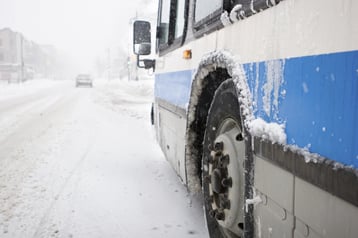Planning for the Future and Unexpected Changes in Weather Patterns
Changes in climate and weather patterns around the world have had significant impacts on businesses, individuals, and government agencies, especially in the public transit sector. In 2017 alone, weather and climate disasters caused $16 billion in damage across the United States. Whether it's flooding from hurricanes in New York City, massive snowstorms in Boston, or devastating California wildfires, transit agencies need to embrace a culture of resiliency and be prepared to respond to disruptions on the fly when their riders rely on them most.
Climate Incidents and Their Impact on Transit
Extreme inclement weather can strain an agency in a number of ways, from higher-than-average ridership to unexpected detours or delays. Managing the unexpected when it happens can help an agency become more resilient in the face of a changing climate.
Extreme weather can suddenly cripple the infrastructure that a transit agency relies on in numerous scenarios. Here are some real-world examples of how changing climates have had an impact on transit:
- In 2015, the Boston metropolitan area faced record-breaking snowfall numbers and persistent cold temperatures, causing severe delays on subway lines due to a shortage of functioning subway cars and replacing trolleys with shuttle buses. The head of the MBTA encouraged commuters to forego using public transit altogether to alleviate strain on the system. Not an ideal scenario for riders who rely on a public transit agency to move themselves to work, school, or other appointments, regardless of how much snow is on the ground.
- California’s continuing struggle with wildfires in 2019 has prompted Bay Area Rapid Transit to formulate a contingency plan if its power supplier, PG&E, turns off electricity in designated areas to lessen the threat of fires starting from power lines.
- Network Rail in the U.K. must keep trains running even in unseasonably warm British summers. Rail lines in direct sunlight can be 68°F hotter than the air temperature during unseasonable heatwaves, causing the steel tracks to expand and begin to curve, known as “buckling”. Despite preventative measures, tracks can still buckle and cannot be repaired until the rail temperature has dropped, causing disruptions and delays.
- Superstorm Sandy caused serious damage to New York’s subway system, flooding tunnels with corrosive saltwater and causing billions of dollars in damage. Repairs to the L train tunnel are projected to close the line for nearly a year beginning in April 2019, forcing commuters on the line to seek out alternate routes between Brooklyn and Manhattan and within the city.
Is Your Transit Agency Climate-Resilient?

In the context of disruption management, resilience is defined by a transit system’s ability to continue functioning efficiently to move riders from one place to another when faced with disruptive or unexpected conditions. This goes for not only everyday service disruptions but also catastrophic weather events. Transportation resilience is of the greatest concern to the individuals and communities that an agency serves.
Regardless of where you stand on the political spectrum, and whether you believe that we have caused, and ultimately can stop or reverse the warming of our planet, the data suggests a shift in the severity of storms over the past decade. Simply sweeping the problem under the rug will not make the challenges we face from a changing climate disappear, but will only serve to create more severe problems down the road.
Transit agencies must analyze all possible scenarios in their region to implement an effective contingency plan that addresses issues before they occur. The key to becoming resilient is offering riders alternatives that still allow them to reach their destination despite these issues.
Leveraging Disruption Management for Climate Resilience
The Disruption Management module in CleverCAD allows agencies to react quickly to service disruptions that occur due to inclement weather, traffic, and road conditions, or vehicle maintenance issues. Users can make service changes to address issues on the fly, and all changes are immediately reflected on vehicles and in our BusTime real-time passenger information system. This ensures that both operators and passengers have access to up-to-date information in real time.
The Disruption Management module addresses four principal areas, including:
- Bus Bridging/Shuttle Service- Quickly create a brand-new trip or route to accommodate a major disruption or unplanned demand for service.
- Same-Day Service Change- Quickly modify the service day (e.g., weekday, weekend) in anticipation of a change in operations or ridership, such as during a major snowstorm.
- Detours- Quickly react to road closures, such as during severe flooding, by rerouting a vehicle, creating an alternate route path.
- Service Restoration- After the snow has melted or water has receded, restore service to its regular schedule.
Learn more about how Disruption Management for CleverCAD can help your agency become more resilient.